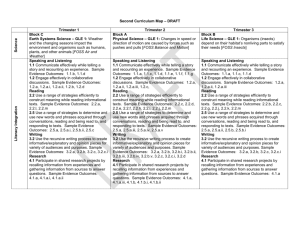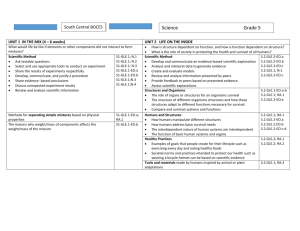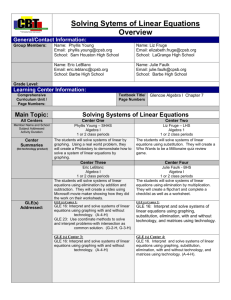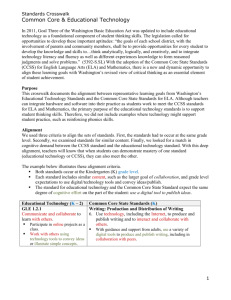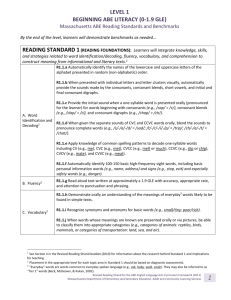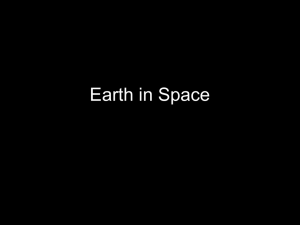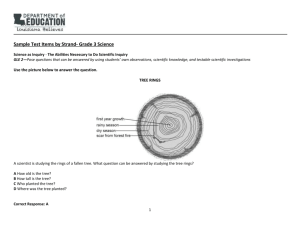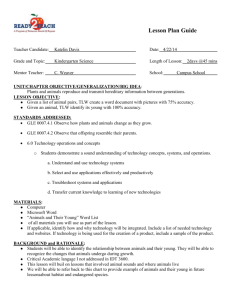Kindergarten Curriculum Map
advertisement
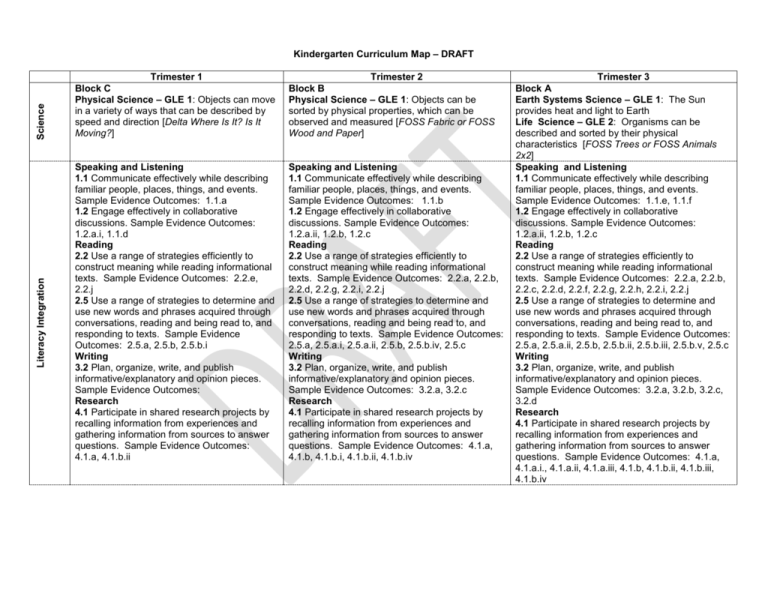
Literacy Integration Science Kindergarten Curriculum Map – DRAFT Trimester 1 Block C Physical Science – GLE 1: Objects can move in a variety of ways that can be described by speed and direction [Delta Where Is It? Is It Moving?] Trimester 2 Block B Physical Science – GLE 1: Objects can be sorted by physical properties, which can be observed and measured [FOSS Fabric or FOSS Wood and Paper] Speaking and Listening 1.1 Communicate effectively while describing familiar people, places, things, and events. Sample Evidence Outcomes: 1.1.a 1.2 Engage effectively in collaborative discussions. Sample Evidence Outcomes: 1.2.a.i, 1.1.d Reading 2.2 Use a range of strategies efficiently to construct meaning while reading informational texts. Sample Evidence Outcomes: 2.2.e, 2.2.j 2.5 Use a range of strategies to determine and use new words and phrases acquired through conversations, reading and being read to, and responding to texts. Sample Evidence Outcomes: 2.5.a, 2.5.b, 2.5.b.i Writing 3.2 Plan, organize, write, and publish informative/explanatory and opinion pieces. Sample Evidence Outcomes: Research 4.1 Participate in shared research projects by recalling information from experiences and gathering information from sources to answer questions. Sample Evidence Outcomes: 4.1.a, 4.1.b.ii Speaking and Listening 1.1 Communicate effectively while describing familiar people, places, things, and events. Sample Evidence Outcomes: 1.1.b 1.2 Engage effectively in collaborative discussions. Sample Evidence Outcomes: 1.2.a.ii, 1.2.b, 1.2.c Reading 2.2 Use a range of strategies efficiently to construct meaning while reading informational texts. Sample Evidence Outcomes: 2.2.a, 2.2.b, 2.2.d, 2.2.g, 2.2.i, 2.2.j 2.5 Use a range of strategies to determine and use new words and phrases acquired through conversations, reading and being read to, and responding to texts. Sample Evidence Outcomes: 2.5.a, 2.5.a.i, 2.5.a.ii, 2.5.b, 2.5.b.iv, 2.5.c Writing 3.2 Plan, organize, write, and publish informative/explanatory and opinion pieces. Sample Evidence Outcomes: 3.2.a, 3.2.c Research 4.1 Participate in shared research projects by recalling information from experiences and gathering information from sources to answer questions. Sample Evidence Outcomes: 4.1.a, 4.1.b, 4.1.b.i, 4.1.b.ii, 4.1.b.iv Trimester 3 Block A Earth Systems Science – GLE 1: The Sun provides heat and light to Earth Life Science – GLE 2: Organisms can be described and sorted by their physical characteristics [FOSS Trees or FOSS Animals 2x2] Speaking and Listening 1.1 Communicate effectively while describing familiar people, places, things, and events. Sample Evidence Outcomes: 1.1.e, 1.1.f 1.2 Engage effectively in collaborative discussions. Sample Evidence Outcomes: 1.2.a.ii, 1.2.b, 1.2.c Reading 2.2 Use a range of strategies efficiently to construct meaning while reading informational texts. Sample Evidence Outcomes: 2.2.a, 2.2.b, 2.2.c, 2.2.d, 2.2.f, 2.2.g, 2.2.h, 2.2.i, 2.2.j 2.5 Use a range of strategies to determine and use new words and phrases acquired through conversations, reading and being read to, and responding to texts. Sample Evidence Outcomes: 2.5.a, 2.5.a.ii, 2.5.b, 2.5.b.ii, 2.5.b.iii, 2.5.b.v, 2.5.c Writing 3.2 Plan, organize, write, and publish informative/explanatory and opinion pieces. Sample Evidence Outcomes: 3.2.a, 3.2.b, 3.2.c, 3.2.d Research 4.1 Participate in shared research projects by recalling information from experiences and gathering information from sources to answer questions. Sample Evidence Outcomes: 4.1.a, 4.1.a.i., 4.1.a.ii, 4.1.a.iii, 4.1.b, 4.1.b.ii, 4.1.b.iii, 4.1.b.iv Social Studies Trimester 1 Civics 4.1 Participate in making decisions using democratic traditions 4.2 Civic participation takes place in multiple groups Economics 3.1 Ownership as a component of economics Trimester 2 History 1.1 Ask questions, share information and discuss ideas about the past 1.2 The first component in the concept of chronology is to place information in sequential order Trimester 3 Geography 2.1 People belong to different groups and live in different places around the world that can be found on a map or globe Economics 3.2 Discuss how purchases can be made to meet wants and needs (PFL) History 1.1 Ask questions, share information and discuss ideas about the past Literacy Skill Development Trimester 1 Speaking and Listening 1.3 Hear, identify and use syllables and sounds in spoken words to make meaning. Sample Evidence Outcomes: 1.3.a.i, 1.3a,ii, 1.3.a.iii, 1.3.a.vi Reading 2.1 Use a range of strategies efficiently to construct meaning while reading literature. Sample Evidence Outcomes: 2.1.e, 2.1.i 2.2 Use a range of strategies efficiently to construct meaning while reading informational texts. Sample Evidence Outcomes: 2.2.e, 2.2.j 2.3 Use concepts of print and the understanding of spoken words to apply gradelevel phonics and word analysis skills to decode words. Sample Evidence Outcomes: 2.3.b, 2.3.c, 2.3.d, 2.3.f, 2.3.g, 2.3.i, 2.3.l, 2.3.n, 2.3.p 2.4 Read texts for meaning, to gain confidence, and fluency. Sample Evidence Outcomes: 2.4.a 2.5 Use a range of strategies to determine and use new words and phrases acquired through conversations, reading and being read to, and responding to texts. Sample Evidence Outcomes: 2.5.a, 2.5.b, 2.5.b.i Writing 3.1 Plan, organize, write, and publish narratives. Sample Evidence Outcomes: 3.1.a 3.2 Plan, organize, write, and publish informative/explanatory and opinion pieces. Sample Evidence Outcomes: 3.3 Apply conventions of standard English grammar and usage, capitalization, punctuation, and spelling consistently. Sample Evidence Outcomes: 3.3.a, 3.3.a.i, 3.3.a.vii, 3.3.a, viii, 3.3.a.ix, 3.3.b, 3.3.b.iii Trimester 2 Speaking and Listening 1.3 Hear, identify and use syllables and sounds in spoken words to make meaning. Sample Evidence Outcomes: 1.3.a.iii, 1.3.a.iv, 1.3.a.vi Reading 2.1 Use a range of strategies efficiently to construct meaning while reading literature. Sample Evidence Outcomes: 2.1.a, 2.1.b, 2.1.d, 2.1.g, 2.1.i 2.2 Use a range of strategies efficiently to construct meaning while reading informational texts. Sample Evidence Outcomes: 2.2.a, 2.2.b, 2.2.d, 2.2.g, 2.2.i, 2.2.j 2.3 Use concepts of print and the understanding of spoken words to apply grade-level phonics and word analysis skills to decode words. Sample Evidence Outcomes: 2.3.a, 2.3.e, 2.3.f, 2.3.h, 2.3.j, 2.3.l, 2.3.m, 2.3.n, 2.3.p, 2.3.q 2.4 Read texts for meaning, to gain confidence, and fluency. Sample Evidence Outcomes: 2.4.a 2.5 Use a range of strategies to determine and use new words and phrases acquired through conversations, reading and being read to, and responding to texts. Sample Evidence Outcomes: 2.5.a, 2.5.a.i, 2.5.a.ii, 2.5.b, 2.5.b.iv, 2.5.c Writing 3.1 Plan, organize, write, and publish narratives. Sample Evidence Outcomes: 3.1.a, 3.1.b 3.2 Plan, organize, write, and publish informative/explanatory and opinion pieces. Sample Evidence Outcomes: 3.2.a, 3.2.c 3.3 Apply conventions of standard English grammar and usage, capitalization, punctuation, and spelling consistently. Sample Evidence Outcomes: 3.3.a, 3.3.a.i, 3.3.a.ii, 3.3.a.v, 3.3.a.vii, 3.3.b, 3.3.b.i, 3.3.b.ii, 3.3.b.iii, 3.3.b.iv Trimester 3 Speaking and Listening 1.3 Hear, identify and use syllables and sounds in spoken words to make meaning. Sample Evidence Outcomes: 1.3.a.iv,1.3.a.v, 1.3.a.vi Reading 2.1 Use a range of strategies efficiently to construct meaning while reading literature. Sample Evidence Outcomes: 2.1.a, 2.1.b, 2.1.c, 2.1.d, 2.1.f, 2.1.g, 2.1.h, 2.1.i 2.2 Use a range of strategies efficiently to construct meaning while reading informational texts. Sample Evidence Outcomes: 2.2.a, 2.2.b, 2.2.c, 2.2.d, 2.2.f, 2.2.g, 2.2.h, 2.2.i, 2.2.j 2.3 Use concepts of print and the understanding of spoken words to apply grade-level phonics and word analysis skills to decode words. Sample Evidence Outcomes: 2.3.e, 2.3.f, 2.3.k, 2.3.l, 2.3.o, 2.3.p, 2.3.q 2.4 Read texts for meaning, to gain confidence, and fluency. Sample Evidence Outcomes: 2.4.a 2.5 Use a range of strategies to determine and use new words and phrases acquired through conversations, reading and being read to, and responding to texts. Sample Evidence Outcomes: 2.5.a, 2.5.a.ii, 2.5.b, 2.5.b.ii, 2.5.b.iii, 2.5.b.v, 2.5.c Writing 3.1 Plan, organize, write, and publish narratives. Sample Evidence Outcomes: 3.1.b, 3.1.c 3.2 Plan, organize, write, and publish informative/explanatory and opinion pieces. Sample Evidence Outcomes: 3.2.a, 3.2.b, 3.2.c, 3.2.d 3.3 Apply conventions of standard English grammar and usage, capitalization, punctuation, and spelling consistently. Sample Evidence Outcomes: 3.3.a, 3.3.a.ii, 3.3.a.iii, 3.3.a.iv, 3.3.a.v, 3.3.a.vi, 3.3.b, 3.3.b.i, 3.3.b.ii, 3.3.b.iii, 3.3.b.iv Mathematics Health Trimester 1 Number Sense – GLE 1: Whole numbers can be used to name, count, represent, and order quantity. Example: Evidence Outcomes: 1.1.c.ii, 1.1.c.iii, 1.1.b.i Number Sense – GLE 2: Composing and decomposing quantity forms the foundation for addition and subtraction. Example: Evidence Outcomes: 1.2.a.i, 1.2b Shape, Dimension and Geometry – GLE 1: Shapes are described by their characteristics and position and created by composing and decomposing. Example: Evidence Outcomes: 4.1.a.i, 4.1.a.ii Shape, Dimension and Geometry – GLE 2: Measurement is used to compare and order objects. Example: Evidence Outcomes: 4.2.a.ii, 4.2.a.iii, 4.2.b.i, 4.2.b.ii Physical and Personal Wellness – GLE 2: Explain how personal hygiene and cleanliness affect wellness Emotional and Social Wellness – GLE 1 Exhibits understanding that one’s actions impact others: on going learning Emotional and Social Wellness – GLE 1e: Explains the concept of friendship Emotional and Social Wellness – GLE 1f: Explains the importance of appreciating self and others Prevention and Risk Management –GLE 2: Explain safe behavior as a pedestrian and with motor vehicles Prevention and Risk Management –GLE 3: Effective communication skills in unsafe situations Trimester 2 Number Sense – GLE 1: Whole numbers can be used to name, count, represent, and order quantity. Example: Evidence Outcomes: 1.1.a.iii, 1.1.b.ii Shape, Dimension and Geometry – GLE 1: Shapes are described by their characteristics and position and created by composing and decomposing. Example: Evidence Outcomes: 4.1.a.iii Shape, Dimension and Geometry – GLE 2: Measurement is used to compare and order objects. Example: Evidence Outcomes: 4.2.a.i Trimester 3 Number Sense – GLE 1: Whole numbers can be used to name, count, represent, and order quantity. Example: Evidence Outcomes: 1.1.a.i, 1.1.c.i. Number Sense – GLE 2: Composing and decomposing quantity forms the foundation for addition and subtraction. Example: Evidence Outcomes: 1.2.a.ii, 1.2.a.iii,1.2.a.iv, 1.2.a.v, 1.2.c Shape, Dimension and Geometry – GLE 1: Shapes are described by their characteristics and position and created by composing and decomposing. Example: Evidence Outcomes: 4.1.b.i Shape, Dimension and Geometry – GLE 2: Measurement is used to compare and order objects. Example: Evidence Outcomes: 4.2.a.iv Emotional and Social Wellness – GLE 1g: Identifies likenesses and differences among people Prevention and Risk Management –GLE 1: Identify the importance of respecting the personal space and boundaries of self and others Physical and Personal Wellness – GLE 1: Identify the major food groups and the benefits of eating a variety of foods Physical and Personal Wellness – GLE 2d: Explain positive out comes from brushing and flossing teeth daily Physical and Personal Wellness – GLE 2e: Demonstrate steps for proper brushing and flossing of teeth

